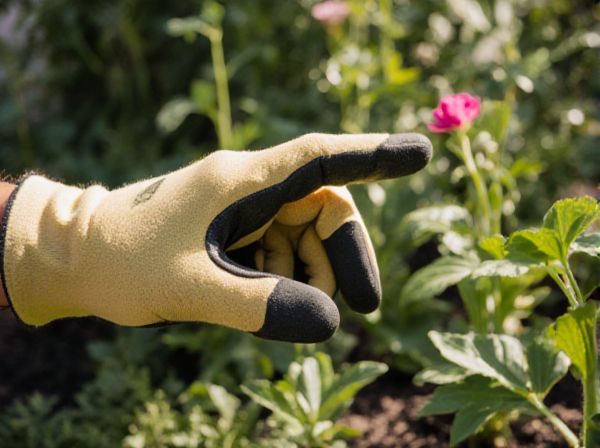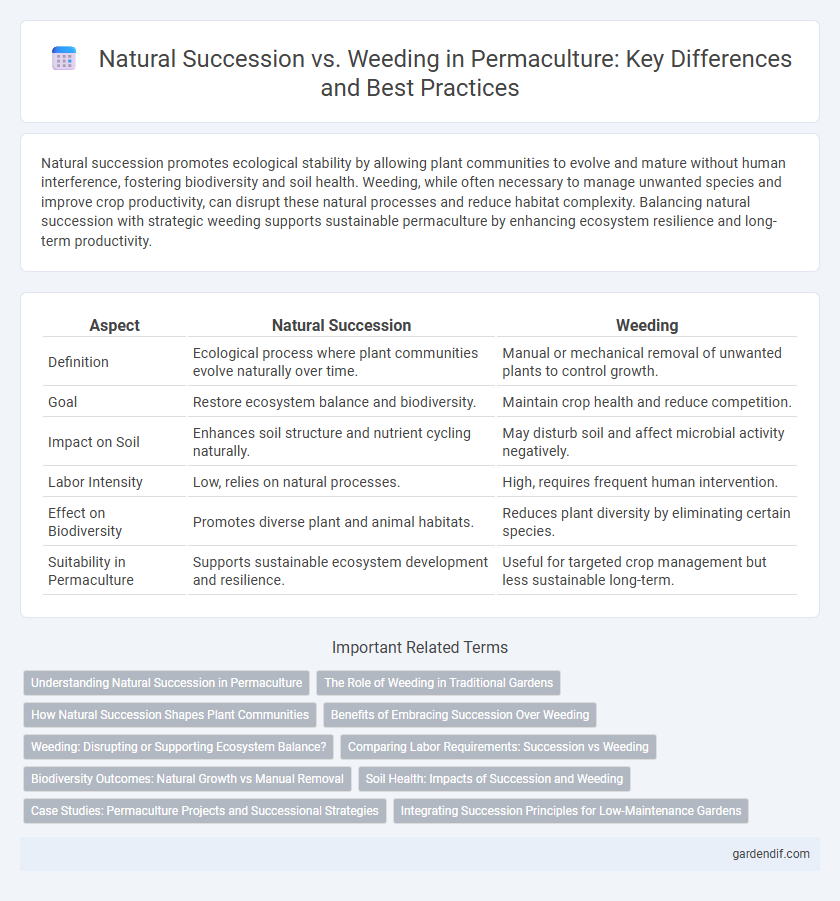
Natural succession vs weeding Illustration
Natural succession promotes ecological stability by allowing plant communities to evolve and mature without human interference, fostering biodiversity and soil health. Weeding, while often necessary to manage unwanted species and improve crop productivity, can disrupt these natural processes and reduce habitat complexity. Balancing natural succession with strategic weeding supports sustainable permaculture by enhancing ecosystem resilience and long-term productivity.
Table of Comparison
| Aspect | Natural Succession | Weeding |
|---|---|---|
| Definition | Ecological process where plant communities evolve naturally over time. | Manual or mechanical removal of unwanted plants to control growth. |
| Goal | Restore ecosystem balance and biodiversity. | Maintain crop health and reduce competition. |
| Impact on Soil | Enhances soil structure and nutrient cycling naturally. | May disturb soil and affect microbial activity negatively. |
| Labor Intensity | Low, relies on natural processes. | High, requires frequent human intervention. |
| Effect on Biodiversity | Promotes diverse plant and animal habitats. | Reduces plant diversity by eliminating certain species. |
| Suitability in Permaculture | Supports sustainable ecosystem development and resilience. | Useful for targeted crop management but less sustainable long-term. |
Understanding Natural Succession in Permaculture
Natural succession in permaculture is the natural process of ecosystem development where plant communities evolve over time, leading to increased biodiversity and soil fertility. Understanding this progression helps permaculturists design systems that work with natural growth patterns instead of constantly removing plants through weeding. Allowing natural succession promotes resilient landscapes that require less maintenance and support sustainable food production.
The Role of Weeding in Traditional Gardens
Weeding in traditional gardens plays a crucial role in managing natural succession by selectively removing invasive species that compete with desirable plants for nutrients, water, and sunlight. This practice supports soil health and biodiversity by preventing dominant weeds from disrupting the balance of native flora. Controlled weeding promotes the growth of cultivated crops and beneficial plants, enhancing overall garden productivity and ecosystem resilience.
How Natural Succession Shapes Plant Communities
Natural succession drives the gradual transformation of plant communities by allowing pioneer species to establish and modify the environment, leading to increased biodiversity and ecosystem stability. Weeding interrupts this process by selectively removing vegetation, thereby influencing species composition and potentially reducing habitat complexity. Understanding natural succession enables permaculture practitioners to design resilient landscapes that harness ecological dynamics rather than relying on continual disturbance.
Benefits of Embracing Succession Over Weeding
Embracing natural succession in permaculture fosters resilient ecosystems by promoting soil health, biodiversity, and nutrient cycling more effectively than frequent weeding. Allowing native plants to establish reduces erosion and enhances habitat complexity, supporting beneficial wildlife and pollinators critical for sustainable growth. This approach lowers labor and input costs while creating self-sustaining landscapes that adapt naturally to environmental changes.
Weeding: Disrupting or Supporting Ecosystem Balance?
Weeding plays a critical role in managing plant competition and directing natural succession within permaculture systems by selectively removing invasive or aggressive species that can disrupt ecosystem balance. Strategic weeding supports biodiversity by allowing desired native plants and beneficial species to establish, enhancing soil health and nutrient cycling. Understanding the timing and method of weeding ensures it functions as a tool for ecosystem support rather than disruption, promoting a resilient and self-sustaining permaculture environment.
Comparing Labor Requirements: Succession vs Weeding
Natural succession requires significantly less labor compared to weeding since it involves allowing native plants to establish and thrive naturally, reducing the need for human intervention. Weeding demands continuous, manual effort to remove unwanted plants and maintain garden aesthetics, which can be labor-intensive and time-consuming. Emphasizing natural succession in permaculture reduces labor input and fosters a self-sustaining ecosystem.
Biodiversity Outcomes: Natural Growth vs Manual Removal
Natural succession promotes diverse plant communities by allowing native species to establish and thrive, enhancing soil health and ecosystem resilience. Manual weeding disrupts these processes by removing vegetation, often reducing habitat complexity and limiting species diversity. Supporting natural growth results in richer biodiversity outcomes compared to the frequent disturbance caused by weeding practices.
Soil Health: Impacts of Succession and Weeding
Natural succession enhances soil health by promoting diverse plant communities that improve nutrient cycling, increase organic matter, and boost microbial activity. In contrast, frequent weeding disrupts these processes by removing key plants that stabilize soil structure and reduce erosion. Maintaining natural succession supports long-term soil fertility and resilience, while excessive weeding can lead to soil degradation and reduced ecosystem function.
Case Studies: Permaculture Projects and Successional Strategies
Case studies in permaculture reveal natural succession as a powerful tool for enhancing soil fertility and increasing biodiversity over time, often outperforming conventional weeding in labor efficiency and ecosystem resilience. Projects such as the Zaytuna Farm in Australia successfully integrate successional strategies, allowing pioneer species to establish and improve microclimates for later crops, reducing the need for constant disturbance. These examples demonstrate how successional design optimizes plant communities, decreases weed pressure naturally, and promotes sustainable yield cycles.
Integrating Succession Principles for Low-Maintenance Gardens
Integrating natural succession principles in permaculture designs reduces the need for frequent weeding by allowing plant communities to self-organize and stabilize over time. Emphasizing pioneer species that enrich soil and create microclimates encourages a resilient, dynamic ecosystem that suppresses invasive weeds naturally. This approach promotes low-maintenance gardens by aligning plant selection and placement with ecological succession stages, enhancing biodiversity and soil health.
Natural succession vs weeding Infographic

 gardendif.com
gardendif.com